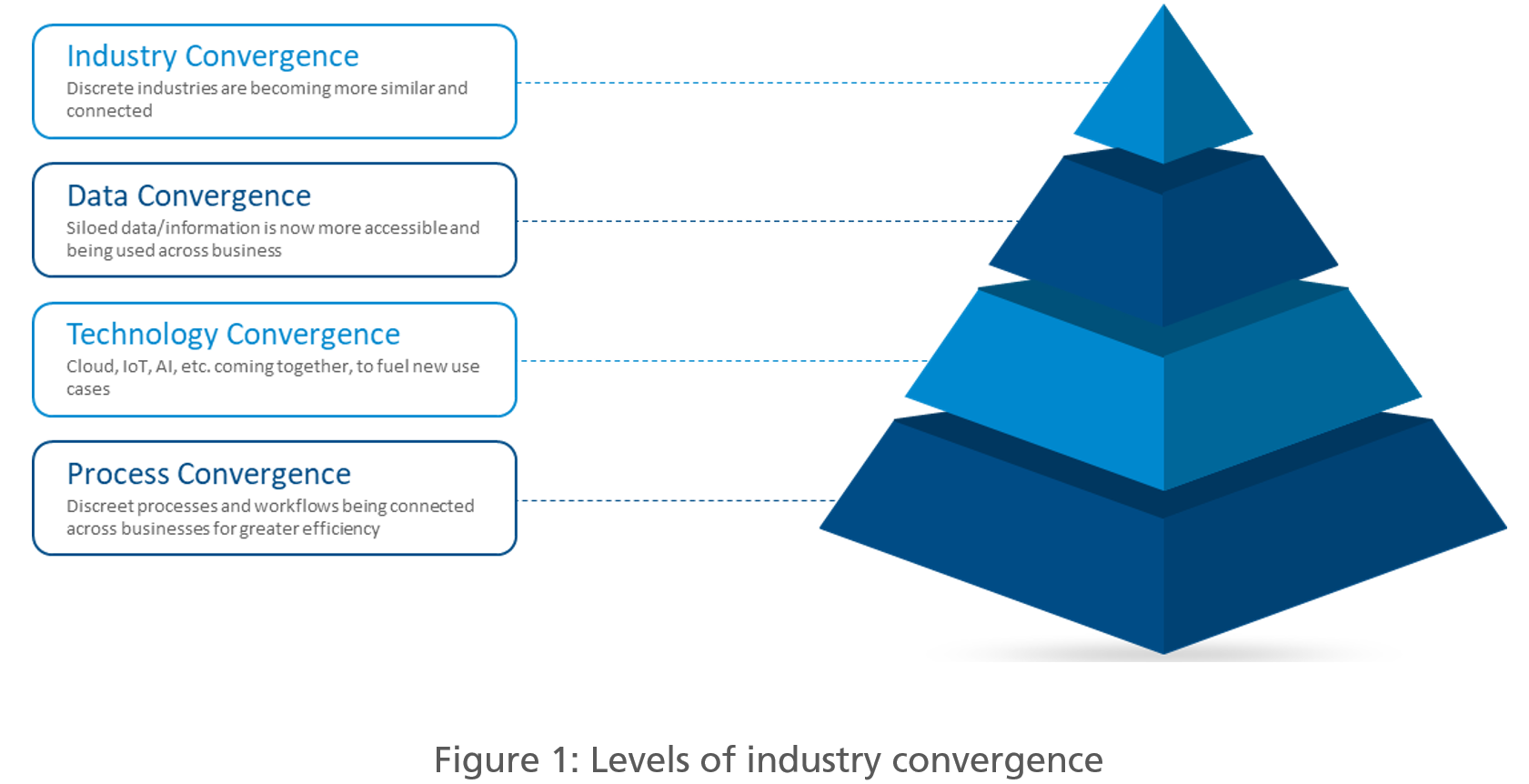Reinventing Digital with Industry Convergence
Amid rapid digital advancements, a sound digital transformation strategy is not just “nice to have” – it’s essential.
Introduction
When was the last time you planned your vacation? We bet you did it yourself since it’s easy to find and book online. The travel and tourism industry has witnessed a phenomenal evolution in the last few years. Initially, travel agents planned our trips, but now we do that using smartphones. It is convenient to book, modify, pay, and insure your trip.
Ever wondered why? What dynamics nudged the travel industry to reimagine its offerings converging into unrelated sectors? What influences such an evolution?
Background: Convergence or Diversification?
The evolution of business sectors is primarily based on the concepts of diversification and convergence. Businesses leverage diversification as a strategy to maximize revenue and hedge risks across sectors.
Convergence is one such strategy, often resulting from unnoticeable years of technology R&D, emerging rapidly in optimal conditions. It certainly creates something unseen before and forces the players to take notice.
This phenomenon has been around for a very long time. In the past, electrically powered telegraph systems revolutionized signaling in railways. Recently, the computer and mobile phone sectors converged the power of computing and sleek touch user interface to start the smartphone revolution. Another example is the convergence of the health and smartphone industries, resulting in wearable gadgets displaying key health parameters in real time.
How do we define industry convergence?
Convergence is a point of confluence or a tipping point where technology, unrelated sectors, or ecosystems come together. It can be defined as the convergence of people, processes, and technologies, which form the critical building blocks for any industry. This new converged sector has the properties of all the constituent industries and is a new disrupted industry on its own.
Let’s look at our cars. From being just a mode of transport powered by gasoline, today’s machines are powered by algorithms (autonomous), and others have a host of features, making them “smart” (fitted with intelligent systems). The smart infotainment system, autonomous driving, and many other features are a result of the convergence of the automobile industry with IT.
Another revolutionary event is currency and bullion going digital. When was the last time you walked into a bank for a transaction? This convergence has transformed physical cash into mere digits on a smart device.
Levels of industry convergence
Convergence is a transformation journey across four evolutionary levels—process, data, technology, and industry.

Process convergence
It is the foundation to achieve synergy across departments and business functions. For example, a large CPG retail giant has started offering health-related services such as health screening tests and insurance plans. They first collected the right (health) data and their regular customers’ usual purchase data to target the right audience. To do so, they integrated their data collection process to fulfill both objectives, thus leading to process convergence.
Technology convergence
As processes converge, systems and technologies, once used only for specific processes, start interacting and integrating.
The CPG company mentioned above started capturing data about their customers’ health at the time of sale. Point-of-sale (POS) applications and technologies, which were used only for capturing sales data, were now being used to capture health-related data of customers, thus leading to technology convergence. They also integrated their mobile shopping application with various health-tracking applications and devices to get real-time data about customers’ health and fitness routines.
Data convergence
The convergence of processes, systems, and technologies makes the previously siloed data more accessible across business functions. It can now be leveraged to execute a wider range of use cases.
The CPG company mentioned above started capturing customers’ health data based on buying patterns. The data from their mobile application and integration with other tracking devices enabled the company to offer unique shopping experiences to their customers.
Industry convergence
Convergence is the integration of seemingly disparate technology, industries, and ideas. It helps to shape intuitive, advanced, and desirable products and services, fueling further innovation and transformation of business landscapes.
In the above example, two industries–retail and health–have converged to offer unique health services to their customers, making way for a new business model to flourish.
What does it mean for businesses and brands?
Levels of industry convergence must be a conscious element of a company’s digital transformation strategy to leverage its unique benefits. Some of the compelling aspects are:
- Value-driven narratives
Customers lean toward brands that can solve their problems uniquely and deliver value, especially when spending is selective.
e.g., Customers are increasingly looking to brands to deliver promises of sustainability. Looking beyond the usual solutions and leveraging convergence will be a game changer. - Socio-economic endurance
Convergence can be a potent antidote for a stagnating market or during an economic downturn. Studies have shown that companies intending to leverage value-driven trends and innovation have a better chance to break any economic stalemate and showcase value.e.g., Digital collaboration tools and platforms as a business continuity strategy - Leveraging the qualities that matter
By traversing industry boundaries, a business can identify unique qualities that can help understand how to solve problems efficiently. During the pandemic, many digitally mature organizations were able to leverage their convergent ecosystems to differentiate and deliver superior value to their customers.e.g., Apple introduced the capability to measure blood oxygen levels using the Apple Watch to stay relevant. - Cradle of human ingenuity
By focusing on innovation and product creation, companies can develop cutting-edge services and products that were previously inconceivable. A convergent ecosystem provides a cradle to nurture creativity, the hallmark of modern civilization and conscious living.e.g., Travel platforms can now make the traveler aware of the sustainability metrics for flight journeys and hotel stays.
Conclusion
It is an era of industrial digitalization and digital industrialization, with digital transformation at the heart of convergence. Businesses that understand the nature of digital transformation strategize well, maneuver, stay ahead of the curve, and remain tenacious in the face of socio-economic uncertainties.
We, at LTIMindtree, understand and help businesses shape digital transformation strategies.
More on Convergence: Explore our take on how the convergence of IT & OT systems can help accelerate digital transformation for manufacturing companies.
References:
- Industry And Technology Convergence: The Next Frontier, Sanjeev Vohra, Anantha Chandrakasan and Koen Deryckere: https://chiefexecutive.net/industry-and-technology-convergence-the-next-frontier/
- Industry Convergence and Disruptive Technologies are Key Growth Areas of the Global Shared Mobility Market, 2030, Frost & Sullivan, November 9, 2020: https://store.frost.com/industry-convergence-and-disruptive-technologies-are-key-growth-areas-of-the-global-shared-mobility-market-2030.html
- Understanding Convergence: The Next Wave of Digital Transformation, Charlene Li, Altimeter, October 25, 2021: https://damassets.autodesk.net/content/dam/autodesk/www/campaigns/discover-convergence/assets/2021-understanding-convergence-usca.pdf
- The Convergence of Convergence: Examples of Digital, Media, Video, Technology and Industry Converging in the 21st Century, Christy Roland, February 8, 2022: https://developer.att.com/blog/examples-of-convergence
- Riding out the storm of industry convergence: how do alliance and acquisition experience matter for firm survival? | Emerald Insight, Sean Tsuhsiang Hsu, March 5, 2021: https://www.emerald.com/insight/content/doi/10.1108/IJOA-05-2020-2225/full/html
- How we helped Microsoft conceptualize a new Industry Convergence, Spur Reply: https://spur-reply.com/microsoft-conceptualize-industry-convergence
- Empowering better care, everywhere, for everyone with Retail+Health, Neil Jordan, June 29, 2021: https://cloudblogs.microsoft.com/industry-blog/health/2021/06/29/empowering-better-care-everywhere-for-everyone-with-retailhealth/
Latest Blogs
he supply chain is a network of suppliers, factories, logistics, warehouses, distributers and…
Introduction What if training powerful AI models didn’t have to be slow, expensive, or data-hungry?…
Pharmaceutical marketing has evolved significantly with digital platforms, but strict regulations…
Leveraging the right cloud technology with appropriate strategies can lead to significant cost…





